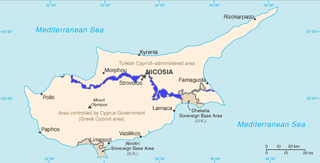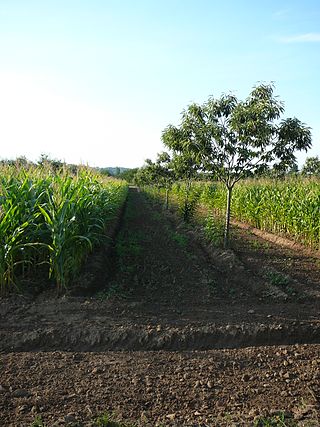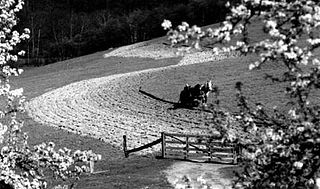
A buffer zone is a neutral zonal area that lies between two or more bodies of land, usually pertaining to countries. Depending on the type of buffer zone, it may serve to separate regions or conjoin them. Common types of buffer zones are demilitarized zones, border zones and certain restrictive easement zones and green belts. Such zones may be comprised by a sovereign state, forming a buffer state.
Natural Resources Conservation Service (NRCS), formerly known as the Soil Conservation Service (SCS), is an agency of the United States Department of Agriculture (USDA) that provides technical assistance to farmers and other private landowners and managers.

A windbreak (shelterbelt) is a planting usually made up of one or more rows of trees or shrubs planted in such a manner as to provide shelter from the wind and to protect soil from erosion. They are commonly planted in hedgerows around the edges of fields on farms. If designed properly, windbreaks around a home can reduce the cost of heating and cooling and save energy. Windbreaks are also planted to help keep snow from drifting onto roadways or yards. Farmers sometimes use windbreaks to keep snow drifts on farm land that will provide water when the snow melts in the spring. Other benefits include contributing to a microclimate around crops, providing habitat for wildlife, and, in some regions, providing wood if the trees are harvested.

Nutrient management is the science and practice directed to link soil, crop, weather, and hydrologic factors with cultural, irrigation, and soil and water conservation practices to achieve optimal nutrient use efficiency, crop yields, crop quality, and economic returns, while reducing off-site transport of nutrients (fertilizer) that may impact the environment. It involves matching a specific field soil, climate, and crop management conditions to rate, source, timing, and place of nutrient application.

Agroforestry is a land use management system in which combinations of trees or shrubs are grown around or among crops or pastureland. Agroforestry combines agricultural and forestry technologies to create more diverse, productive, profitable, healthy, and sustainable land-use systems. There are many benefits to agroforestry such as increasing farm profitability. In addition, agroforestry helps to preserve and protect natural resources such as controlling soil erosions, creating habitat for the wildlife, and managing animal waste. Benefits also include increased biodiversity, improved soil structure and health, reduced erosion, and carbon sequestration.

Agricultural wastewater treatment is a farm management agenda for controlling pollution from confined animal operations and from surface runoff that may be contaminated by chemicals in fertilizer, pesticides, animal slurry, crop residues or irrigation water. Agricultural wastewater treatment is required for continuous confined animal operations like milk and egg production. It may be performed in plants using mechanized treatment units similar to those used for industrial wastewater. Where land is available for ponds, settling basins and facultative lagoons may have lower operational costs for seasonal use conditions from breeding or harvest cycles. Animal slurries are usually treated by containment in anaerobic lagoons before disposal by spray or trickle application to grassland. Constructed wetlands are sometimes used to facilitate treatment of animal wastes.

Contour bunding or contour farming or Contour ploughing is the farming practice of plowing and/or planting across a slope following its elevation contour lines. These contour lines create a water break which reduces the formation of rills and gullies during times of heavy precipitation, allowing more time for the water to settle into the soil. In contour plowing, the ruts made by the plow run perpendicular rather than parallel to the slopes, generally furrows that curve around the land and are level. This method is also known for preventing tillage erosion. Tillage erosion is the soil movement and erosion by tilling a given plot of land. A similar practice is contour bunding where stones are placed around the contours of slopes. Contour ploughing has been proved to reduce fertilizer loss, power and time consumption, and wear on machines, as well as to increase crop yields and reduces soil erosion.

Soil conservation is the prevention of loss of the topmost layer of the soil from erosion or prevention of reduced fertility caused by over usage, acidification, salinization or other chemical soil contamination.

Strip cropping is a method of farming which involves cultivating a field partitioned into long, narrow strips which are alternated in a crop rotation system. It is used when a slope is too steep or when there is no alternative method of preventing soil erosion. The most common crop choices for strip cropping are closely sown crops such as hay, wheat, or other forages which are alternated with strips of row crops, such as corn, soybeans, cotton, or sugar beets. The forages serve primarily as cover crops. In certain systems, strips in particularly eroded areas are used to grow permanent protective vegetation; in most systems, however, all strips are alternated on an annual basis.

In agriculture, a living mulch is a cover crop interplanted or undersown with a main crop, and intended to serve the purposes of a mulch, such as weed suppression and regulation of soil temperature. Living mulches grow for a long time with the main crops, whereas cover crops are incorporated into the soil or killed with herbicides.

A riparian zone or riparian area is the interface between land and a river or stream. In some regions, the terms riparian woodland, riparian forest, riparian buffer zone,riparian corridor, and riparian strip are used to characterize a riparian zone. The word riparian is derived from Latin ripa, meaning "river bank".

Erosion control is the practice of preventing or controlling wind or water erosion in agriculture, land development, coastal areas, river banks and construction. Effective erosion controls handle surface runoff and are important techniques in preventing water pollution, soil loss, wildlife habitat loss and human property loss.

Nonpoint source (NPS) pollution refers to diffuse contamination of water or air that does not originate from a single discrete source. This type of pollution is often the cumulative effect of small amounts of contaminants gathered from a large area. It is in contrast to point source pollution which results from a single source. Nonpoint source pollution generally results from land runoff, precipitation, atmospheric deposition, drainage, seepage, or hydrological modification where tracing pollution back to a single source is difficult. Nonpoint source water pollution affects a water body from sources such as polluted runoff from agricultural areas draining into a river, or wind-borne debris blowing out to sea. Nonpoint source air pollution affects air quality, from sources such as smokestacks or car tailpipes. Although these pollutants have originated from a point source, the long-range transport ability and multiple sources of the pollutant make it a nonpoint source of pollution; if the discharges were to occur to a body of water or into the atmosphere at a single location, the pollution would be single-point.

The Conservation Reserve Program (CRP) is a cost-share and rental payment program of the United States Department of Agriculture (USDA). Under the program, the government pays farmers to take certain agriculturally used croplands out of production and convert them to vegetative cover, such as cultivated or native bunchgrasses and grasslands, wildlife and pollinators food and shelter plantings, windbreak and shade trees, filter and buffer strips, grassed waterways, and riparian buffers. The purpose of the program is to reduce land erosion, improve water quality and effect wildlife benefits.

Revegetation is the process of replanting and rebuilding the soil of disturbed land. This may be a natural process produced by plant colonization and succession, manmade rewilding projects, accelerated process designed to repair damage to a landscape due to wildfire, mining, flood, or other cause. Originally the process was simply one of applying seed and fertilizer to disturbed lands, usually grasses or clover. The fibrous root network of grasses is useful for short-term erosion control, particularly on sloping ground. Establishing long-term plant communities requires forethought as to appropriate species for the climate, size of stock required, and impact of replanted vegetation on local fauna. The motivations behind revegetation are diverse, answering needs that are both technical and aesthetic, but it is usually erosion prevention that is the primary reason. Revegetation helps prevent soil erosion, enhances the ability of the soil to absorb more water in significant rain events, and in conjunction reduces turbidity dramatically in adjoining bodies of water. Revegetation also aids protection of engineered grades and other earthworks.

A riparian buffer or stream buffer is a vegetated area near a stream, usually forested, which helps shade and partially protect the stream from the impact of adjacent land uses. It plays a key role in increasing water quality in associated streams, rivers, and lakes, thus providing environmental benefits. With the decline of many aquatic ecosystems due to agriculture, riparian buffers have become a very common conservation practice aimed at increasing water quality and reducing pollution.

A grassed waterway is a 2-metre (6.6 ft) to 48-metre-wide native grassland strip of green belt. It is generally installed in the thalweg, the deepest continuous line along a valley or watercourse, of a cultivated dry valley in order to control erosion. A study carried out on a grassed waterway during 8 years in Bavaria showed that it can lead to several other types of positive impacts, e.g. on biodiversity.

Filter strips, also referred to as buffer strips, are small, edge-of-field tracts of vegetated land that are used to reduce the contamination of surface water. They are primarily used in agriculture to control non-point source pollution, however, they may also be used to reduce sediment in storm water runoff from construction sites. There are several types of filter strips including vegetative filter strips, forested riparian buffers, and wind buffers. In agriculture, they are highly effective in reducing the concentration of nitrogen (N) and phosphorus (P) in runoff into surface water and are also effective in reducing sediment erosion and removing pesticides. This helps to prevent eutrophication and associated fishkills and loss of biodiversity. The use of filter strips is very common in developed countries and is required by law in some areas. The implementation and maintenance of filter strips is inexpensive and their use has been shown to be cost effective.

Conservation programs for the Mississippi River watershed have been designed to protect and preserve it by implementing practices that decrease the harmful effects of development on habitats and to overlook monitoring that helps future planning and management. A main focus is nutrient pollution from agricultural runoff of the nation's soybean, corn and food animal production, and problems relating to sediment and toxins. Conservation programs work with local farmers and producers to decrease excess nutrients because they cause major water quality problems along with hypoxia and loss of habitat. Organizations such as the Mississippi River/Gulf of Mexico Watershed Nutrient Task Force and USDA programs such as the Upper Mississippi River Forestry Partnership and the Mississippi River Basin Healthy Watersheds Initiative contribute to conserving what is left of the Mississippi River watershed.
Prairie strips are strips of native perennial vegetation that are strategically integrated into row crop fields. This technique is used in conservation farming to improve biodiversity, and protect soil and water.



















